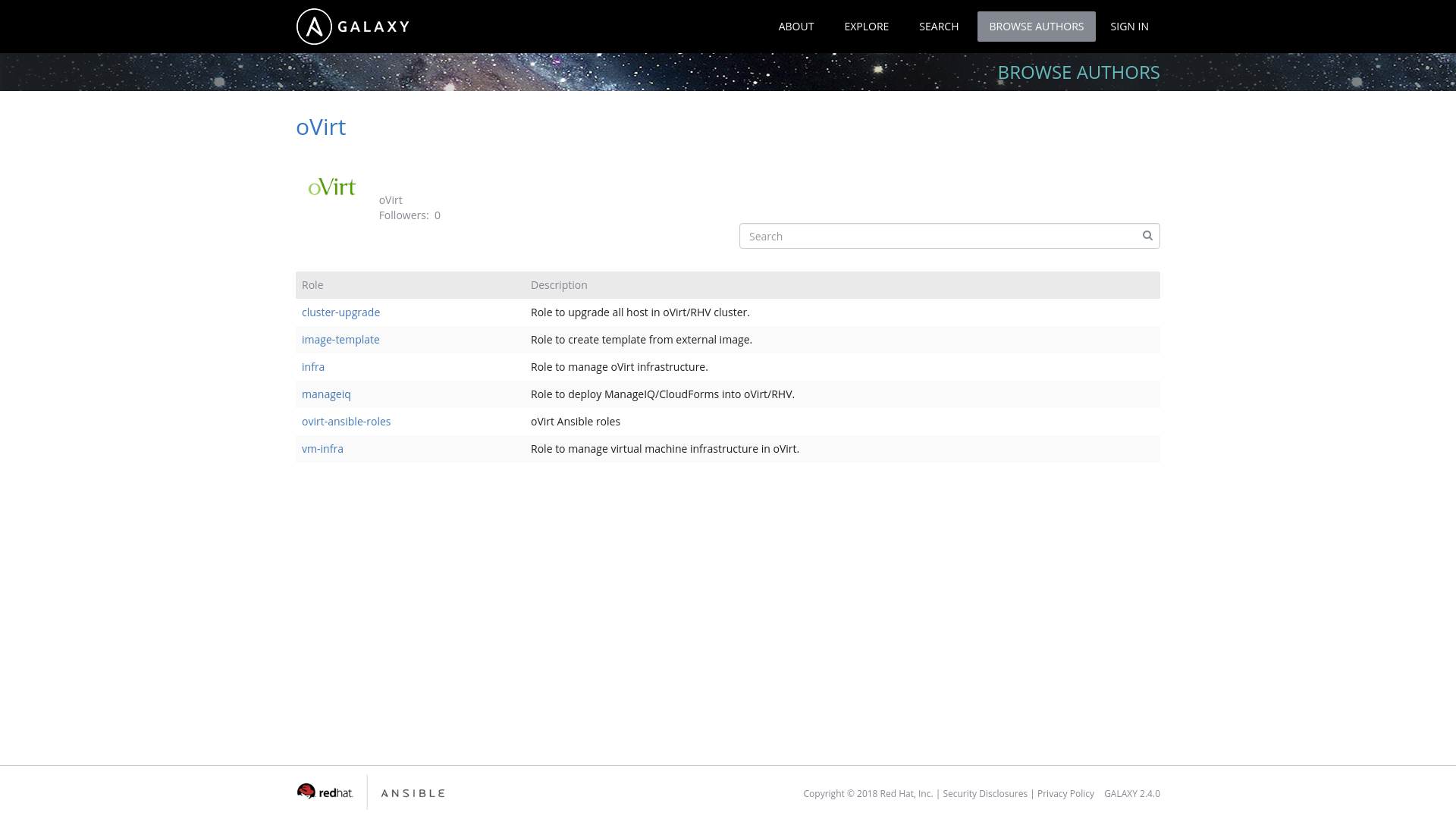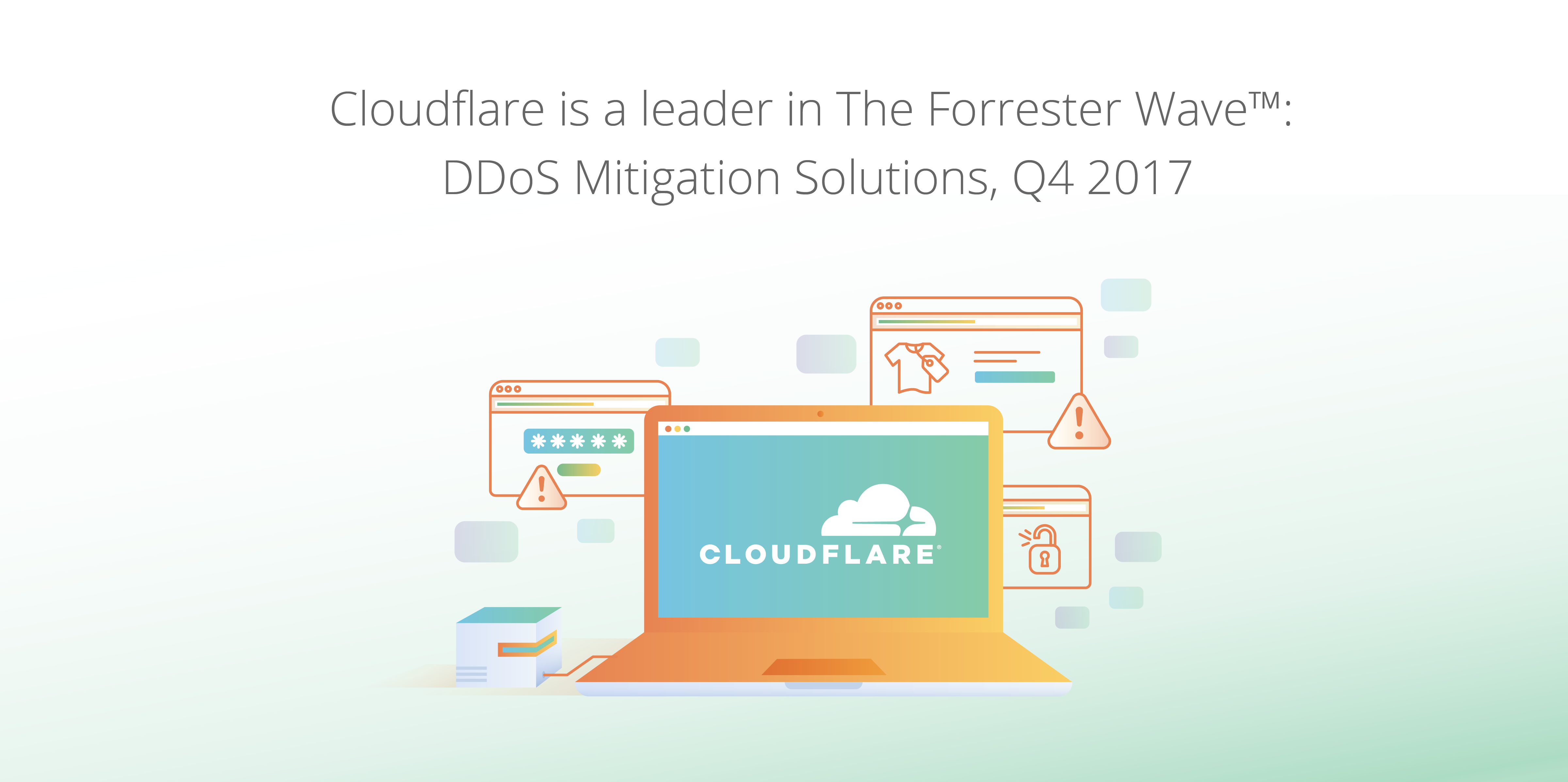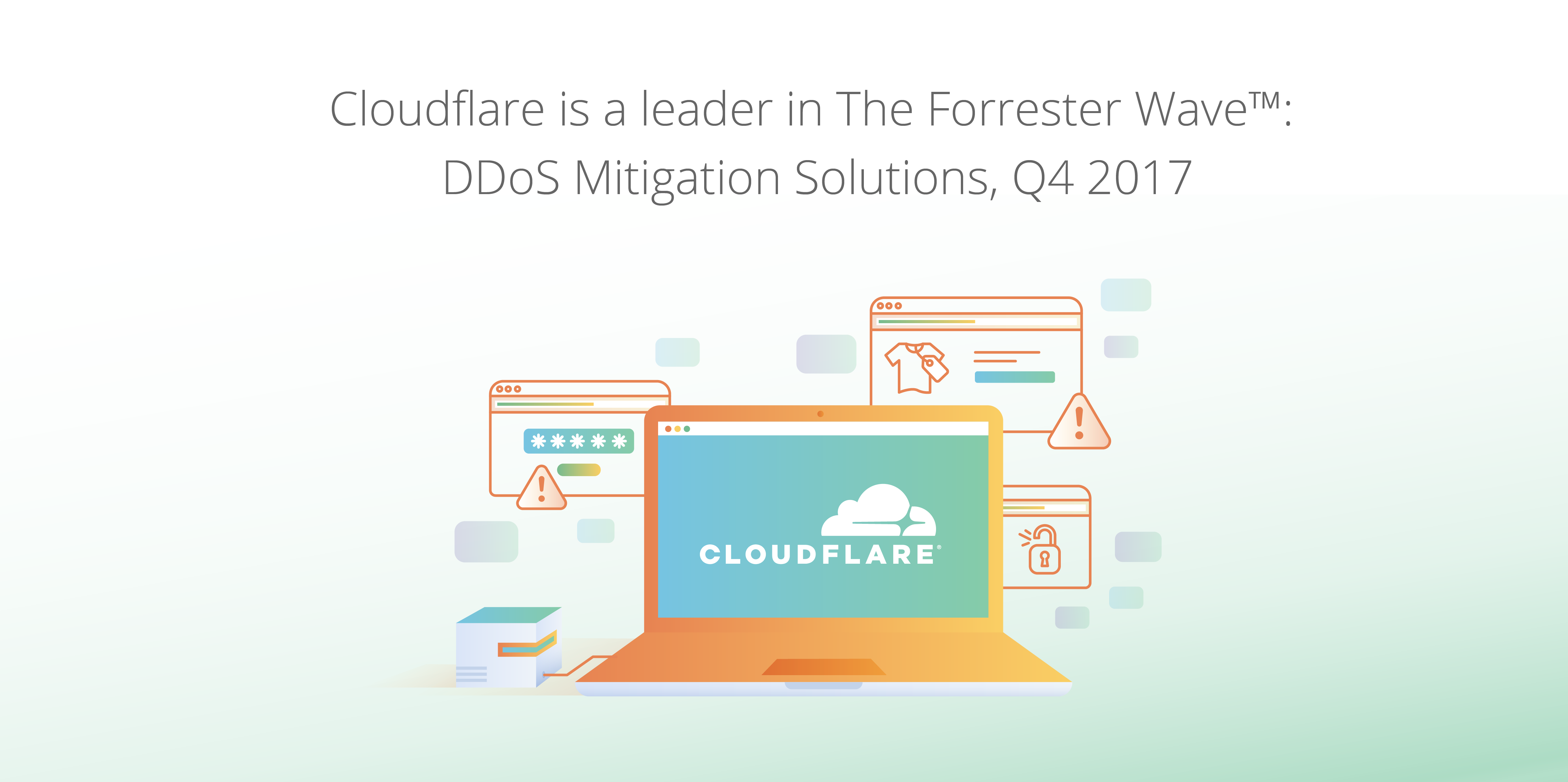oVirt roles Ansible Galaxy integration
In 4.2 release we have splitted our oVirt Ansible roles into separate RPM packages and also separate git repositories, so it is possible for user to install specific role either from Ansible Galaxy or as RPM package.
The reason
The reason to split the roles into separate packages and git repositories was mainly the usage from the AWX/Ansible Tower. Since Ansible Galaxy is only integrated with github you need to store your Ansible role in single git repostiory in order to have separate Ansible role in Galaxy. Previously we used one single repository where we have stored all the roles, but because of that manual configuration was required to make those roles usable in AWX/Ansible Tower. So as you can see on image below we now have many roles in Ansible Galaxy under oVirt user:

How to install the roles
There are still two ways how to install the roles: either using Ansible Galaxy or using RPM package available from oVirt repositories.
Ansible Galaxy
You are now able to install just a single role and not necessarily all of them at once like in previous versions For example to install just oVirt cluster upgrade role, you have to run Continue reading
oVirt roles Ansible Galaxy integration
In 4.2 release we have splitted our oVirt Ansible roles into separate RPM packages and also separate git repositories, so it is possible for user to install specific role either from Ansible Galaxy or as RPM package.
The reason
The reason to split the roles into separate packages and git repositories was mainly the usage from the AWX/Ansible Tower. Since Ansible Galaxy is only integrated with github you need to store your Ansible role in single git repostiory in order to have separate Ansible role in Galaxy. Previously we used one single repository where we have stored all the roles, but because of that manual configuration was required to make those roles usable in AWX/Ansible Tower. So as you can see on image below we now have many roles in Ansible Galaxy under oVirt user:

How to install the roles
There are still two ways how to install the roles: either using Ansible Galaxy or using RPM package available from oVirt repositories.
Ansible Galaxy
You are now able to install just a single role and not necessarily all of them at once like in previous versions For example to install just oVirt cluster upgrade role, you have to run Continue reading
Customizing the host deploy process
In 4.2 release we have introduced a possibility to customize the host-deploy process by running the Ansible post-tasks after the host-deploy process successfully finishes.
The reason
Prior to oVirt 4.2 release administrators could customize host's firewall rules using engine-config option IPTablesConfigSiteCustom.
Unfortunately writing custom iptables rules into string value to be used in engine-config was very user unfriendly and using engine-config to provide custom
firewalld rules would be even much worse. Because of above we have introduced Ansible integration as a part of host deploy flow, which allows administrators to
add any custom actions executed on the host during host deploy flow.
Special tasks file
As part of this role we also include additional tasks, which could be written by the user, to modify the host-deploy process for example to open some more FirewallD ports.
Those additional tasks can be added to following file:
/etc/ovirt-engine/ansible/ovirt-host-deploy-post-tasks.yml
This post-task file is executed as part of host-deploy process just before setup network invocation.
Example
An example post-tasks file is provided by ovirt-engine installation, at following location:
/etc/ovirt-engine/ansible/ovirt-host-deploy-post-tasks.yml.example
This is just an example file, to add some task into host deploy flow, you need to create below mentioned file Continue reading
Building a new IMDB: Internet Mince Pie Database
 CC-BY-SA 2.0 image by Phil! Gold
CC-BY-SA 2.0 image by Phil! Gold
Since joining Cloudflare I’ve always known that as we grew, incredible things would be possible. It’s been a long held ambition to work in an organisation with the scale to answer a very controversial and difficult question. To do so would require a collection of individuals with a depth of experience, passion, dedication & above all collaborative spirit.
As Cloudflare’s London office has grown in the last 4 years I believe 2017 is the year we reach the tipping point where this is possible. A paradigm-shift in the type of challenges Cloudflare is able to tackle. We could finally sample every commercially available mince pie in existence before the 1st of December. In doing so, we would know conclusively which mince pie we should all be buying over Christmas to share with our friends & families.
What is a mince pie?
For the uninitiated, a Mince Pie is “a sweet pie of British origin, filled with a mixture of dried fruits and spices called mincemeat, that is traditionally served during the Christmas season in the English world.” - Wikipedia for Mince Pie
The original Mince Pie was typically filled with a mixture Continue reading
Network Visibility with Barefoot Deep Insight

As you may have heard this week, Barefoot Networks is back in the news with the release of their newest product, Barefoot Deep Insight. Choosing to go down the road of naming a thing after what it actually does, Barefoot has created a solution to finding out why network packets are behaving the way they are.
Observer Problem
It’s no secret that modern network monitoring is coming out of the Dark Ages. ping, traceroute, and SNMP aren’t exactly the best tools to be giving any kind of real information about things. They were designed for a different time with much less packet flow. Even Netflow can’t keep up with modern networks running at multi-gigabit speeds. And even if it could, it’s still missing in-flight data about network paths and packet delays.
Imagine standing outside of the Holland Tunnel. You know that a car entered at a specific time. And you see the car exit. But you don’t know what happened to the car in between. If the car takes 5 minutes to traverse the tunnel you have no way of knowing if that’s normal or not. Likewise, if a car is delayed and takes 7-8 minutes to exit Continue reading
The variability of Internet Traffic
The post The variability of Internet Traffic appeared first on Noction.
Technology Short Take 91
Welcome to Technology Short Take 91! It’s been a bit longer than usual since the last Tech Short Take (partly due to the US Thanksgiving holiday, partly due to vacation time, and partly due to business travel), so apologies for that. Still, there’s a great collection of links and articles here for you, so dig in and enjoy.
Networking
- Amanpreet Singh has a two-part series on Kubernetes networking (part 1, part 2).
- Anthony Spiteri has a brief look at NSX-T 2.1, which recently launched with support for Pivotal Container Service (PKS) and Pivotal Cloud Foundry, further extending the reach of NSX into new areas.
- Jon Benedict has a brief article on OVN and its integration into Red Hat Virtualization; if you’re unfamiliar with OVN, it might be worth having a look.
- sFlow is a networking technology that I find quite interesting, but I never seem to have the time to really dig into it. For example, I was recently browsing the sFlow blog and came across two really neat articles. The first was on RESTful control of Cumulus Linux ACLs (this one isn’t actually sFlow-related); the second was on combining sFlow telemetry and RESTful APIs Continue reading
Software-Defined Data Centers: VMware Designs
Learn best practices for configuring VMware SDDC components in this excerpt from "Building VMware Software-Defined Data Centers."
Video: Switch Buffer Architectures
A while ago (in the time of big-versus-small buffers brouhaha) I asked JR Rivers to do a short presentation focusing on buffering requirements of data center switches. He started by describing typical buffer architectures you might find in data center switches.
Juniper: Send in the Bots for Network Peering, Testing
 Telefónica is already testing the AppFormix Health Bot.
Telefónica is already testing the AppFormix Health Bot.
Installing the Azure CLI on Fedora 27
This post is a follow-up to a post from earlier this year on manually installing the Azure CLI on Fedora 25. I encourage you to refer back to that post for a bit of background. I’m writing this post because the procedure for manually installing the Azure CLI on Fedora 27 is slightly different than the procedure for Fedora 25.
Here are the steps to install the Azure CLI into a Python virtual environment on Fedora 27. Even though they are almost identical to the Fedora 25 instructions (one additional package is required), I’m including all the information here for the sake of completeness.
Make sure that the “gcc”, “libffi-devel”, “python-devel”, “openssl-devel”, “python-pip”, and “redhat-rpm-config” packages are installed (you can use
dnfto take care of this). Some of these packages may already be installed; during my testing with a Fedora 27 Cloud Base Vagrant image, these needed to be installed. (The change from Fedora 25 is the addition of the “redhat-rpm-config” package.)Install virtualenv either with
pip install virtualenvordnf install python2-virtualenv. I useddnf, but I don’t think the method you use here will have any material effects.Create a new Python virtual environment with
Continue reading
Bridging Object Storage And NAS In The Enterprise
Object storage may not have been born in the cloud, but it was the major public cloud providers like Amazon Web Services, Microsoft Azure, and Google Cloud Platform that have been its biggest drivers.
The idea of object storage wasn’t new; it had been around for about two decades. But as the cloud service providers began building out their datacenters and platforms more than a decade ago, they were faced with the need to find a storage architecture that could scale to meet the demands brought on by the massive amounts of data being created, and as well as the …
Bridging Object Storage And NAS In The Enterprise was written by Jeffrey Burt at The Next Platform.
On the Leading Edge – Cloudflare named a leader in The Forrester Wave: DDoS Mitigation Solutions


Cloudflare has been recognized as a leader in the “Forrester WaveTM: DDoS Mitigation Solutions, Q4 2017.”
The DDoS landscape continues to evolve. The increase in sophistication, frequency, and range of targets of DDoS attacks has placed greater demands on DDoS providers, many of which were evaluated in the report.
This year, Cloudflare received the highest scores possible in 15 criteria, including:
- Length of Implementation
- Layers 3 and 4 Attacks Mitigation
- DNS Attack Mitigation
- IoT Botnets
- Multi-Vector Attacks
- Filtering Deployment
- Secure Socket Layer Investigation
- Mitigation Capacity
- Pricing Model
We believe that Cloudflare’s position as a leader in the report stems from the following:
An architecture designed to address high-volume attacks. This post written in October 2016 provides some insight into how Cloudflare’s architecture scales to meet the most advanced DDoS attacks differently than legacy scrubbing centers.
In September 2017, due to the size and effectiveness of our network, we announced the elimination of “surge pricing” commonly found in other DDoS vendors by offering unmetered mitigation. Regardless of what Cloudflare plan a customer is on—Free, Pro, Business, or Enterprise—we will never terminate a customer or charge more based on the size of an attack.
Because we protect over 7 Continue reading